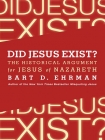Did Jesus Exist? - The Historical Argument for Jesus of Nazareth Bart Ehrman (books to read in your 20s txt) 📖

- Author: Bart Ehrman
Book online «Did Jesus Exist? - The Historical Argument for Jesus of Nazareth Bart Ehrman (books to read in your 20s txt) 📖». Author Bart Ehrman
Q appears to have been made up predominantly of the sayings of Jesus, much like the later Gospel of Thomas. In the judgment of most scholars, Q did not include an account of Jesus’s death and resurrection since Matthew and Luke do not share any stories of the Passion not also found in Mark. In my opinion it is very hard to know whether or not Q lacked a passion narrative. It would have been possible, for example, for Matthew to copy some of the stories of the Passion from Q and for Luke not to include those stories. If so, we would have no way of knowing whether the stories found only in Matthew—including some of the passages in the passion narrative—were in fact Q stories that Luke simply decided not to reproduce for reasons of his own.
Whether or not Q included an account of Jesus’s death and resurrection, it appears that the source must date to a period no later than Mark, and a good number of scholars have dated it earlier, say, to the 50s.
Luke used other sources as well, as he intimates. He doesn’t tell us how many. A lot of stories are found only in Luke, however, such as Jesus’s parables of the prodigal son and of the good Samaritan. Luke must have gotten these from somewhere else: scholars have long offered good reasons for thinking Luke didn’t just make everything else all up. And so they call this other now-lost source L, for Luke’s special source. L may have been one document; it may have been a large number of documents; or it may have included both written documents and oral traditions about Jesus (I will be talking about oral traditions soon).
Matthew as well is based on written sources. As pointed out, he used Mark, even more than Luke did, and Q. But he too includes many stories found only in his Gospel: the visit of the wise men to worship the infant Jesus, for example, and the parable of the sheep and the goats at the last judgment. These then must have come from Matthew’s special source(s), which scholars have therefore labeled M. Like L, M may have been a single written document, a number of documents, or a combination of oral traditions and written sources.
When dealing only with Matthew, Mark, and Luke, the synoptic Gospels, then, we are talking not just about three books written late in the first century. We are talking about at least four sources: Mark, Q, M, and L, the latter two of which could easily have represented several, or even many, other written sources.
Many leading scholars of the Gospel of Mark think that it too was compiled not just of oral traditions that had been circulating down to the author’s day but of various written sources. It is often thought that Mark used a passion narrative that had been written years earlier in which the episodes of Jesus’s arrest, trials, death, and resurrection were already put into written form. The most recent and most authoritative two-volume commentary on Mark, by Joel Marcus, contends that Mark used a source, or a number of sources, for his account of Jesus’s words and deeds prior to the passion narrative.11 If this is right, then not just our later synoptics but even our earliest surviving Gospel was based on multiple sources.
The Gospel of John too is widely thought to have been based on written sources that no longer survive. As I have indicated, the reason for thinking that John does not rely on the synoptics is that whenever they tell the same story, it is in radically different ways and never in the same words. But scholars have long suspected that John had at his disposal an earlier written account of Jesus’s miracles (the so-called Signs Source), at least two accounts of Jesus’s long speeches (the Discourse Sources), and possibly another passion source as well.12
I have been speaking so far only of the four canonical Gospels. It cannot be determined with absolute certainty whether any of the later Gospels—say the Gospel of Peter or the Gospel of Thomas—go back to written sources although in both of these cases some scholars have mounted strenuous arguments that they do. The most plausible case has been made for the Gospel of Thomas by April DeConick, who makes a strong argument, based on a careful literary study of the text, that the core of the surviving Gospel of Thomas goes back to a Gospel in circulation prior to 50 CE.13
All of these written sources I have mentioned are earlier than the surviving Gospels; they all corroborate many of the key things said of Jesus in the Gospels; and most important they are all independent of one another. Let me stress the latter point. We cannot think of the early Christian Gospels as going back to a solitary source that “invented” the idea that there was a man Jesus. The view that Jesus existed is found in multiple independent sources that must have been





Comments (0)